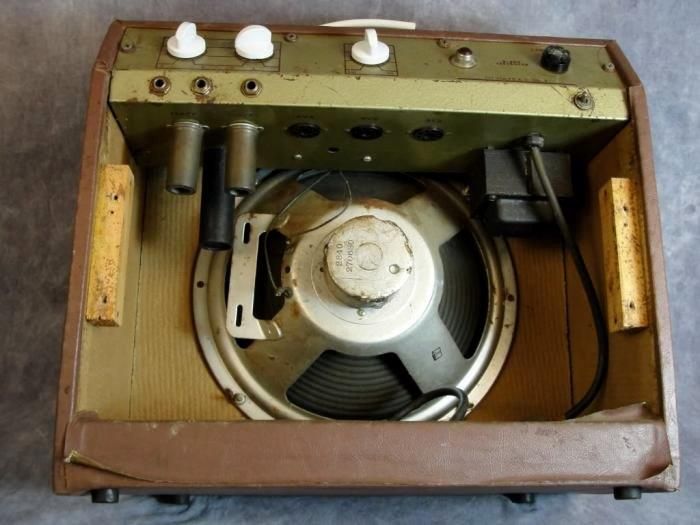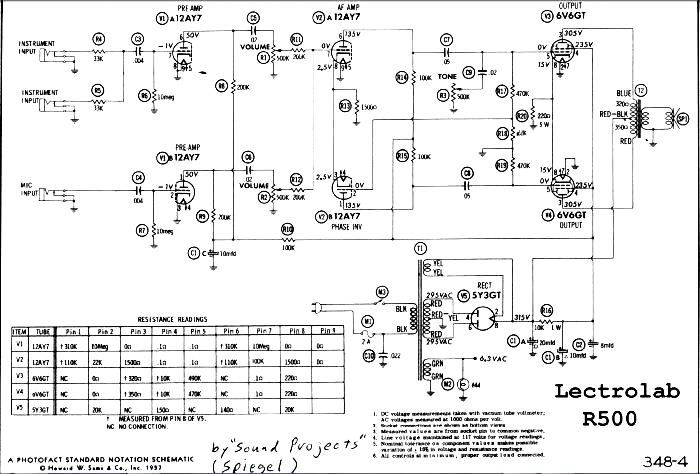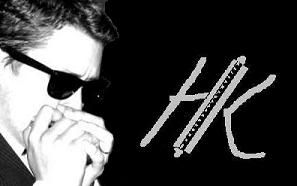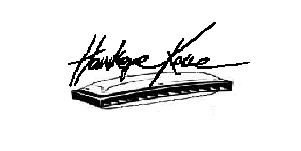Rick Davis
2049 posts
Jul 05, 2013
12:58 PM

|

In another thread the topic of bridging or jumping channels in Bassman–type amps came up, and I have been meaning to devote a thread to this, so here goes.
What exactly is the benefit? What do you hear when you do this? I’ve tried it and I don’t find much use for it.
The bright and normal inputs are different channels because they each have their own volume pot, but the only difference is a bright cap on the bright input. The two volume controls can be used to blend the two inputs and then send the signal along to the tone stack.
So, as far as I can see the result of bridging the channels is 3dB boost in gain and a 50% cut in the impedance your mic sees. It changes the brightness of the signal but that can be accomplished with the tone controls.
What should I be listening for? I’d like to hear from players who regularly do this. Does it work better with some mics than others?
----------
-Little Rick Davis
The Blues Harp Amps Blog
The Mile High Blues Society
Tip Jar
Last Edited by Rick Davis on Jul 05, 2013 1:00 PM
|
bluemoose
900 posts
Jul 05, 2013
1:58 PM

|
The explanation I've seen is to put your mic into normal 1 and bridge bright 1 to normal 2. Start the bright volume low. Set bass/mid/treble and normal channel volume as you like it. When you then increase the bright volume that channel starts to interact with the normal to give you better projection into the house.
Mic differences would depend on if the inputs have higher value resistors to better match impedence and output of crystal mics.
bluemoose
(Premier is kicking it at the jams. Several very happy fellow harpers.)
----------
MBH Webbrain - a GUI guide to Adam's Youtube vids
FerretCat Webbrain - Jason Ricci's vids (by hair colour!)
|
Rick Davis
2050 posts
Jul 05, 2013
2:52 PM

|
Moose, so happy to know the Twin 8 is getting good use! It deserves to be played a lot.
I'll try the Bassman bridging thing again this weekend.
----------
-Little Rick Davis
The Blues Harp Amps Blog
The Mile High Blues Society
Tip Jar
|
walterharp
1126 posts
Jul 05, 2013
8:49 PM

|
yeah, but it is more nuanced than just that because the volume controls on that amp interact regardless of if they are bridged or not.. so bridging probably just makes the two volume controls more equal.. or a bit less independent.
Given all the variables, I have become convinced with each amp the only way to really deal with this is make a varied set of licks into a looping pedal, and run it repeatedly through the amp while changing things and listening, so you have the same signal going in, and change the parameters on your amp. With all the tube differences, speaker differences, mics and players, seems like that is the best approach. At least that way you know the incoming signal stays the same and can listen to what is coming out without hearing your own playing coming directly through your head and ears.
|
5F6H
1649 posts
Jul 06, 2013
4:03 AM

|
It can thicken up tone a little, if you need it. You are then limited by the amount of signal that V2 can handle...so it doesn't give you more volume or anything, just a different sound.
You can also use the effect for playing with mixing wet/dry signals as regards reverb/delay.
I don't use it, or see it used, that much, but it's worth knowing about, maybe for recording?
I prefer to use a 1/4" "y" splitter than running a cable from the #2 to the #1, less effect on tone.
----------
www.myspace.com/markburness
http://www.facebook.com/markburness
Last Edited by 5F6H on Jul 06, 2013 4:05 AM
|
Rick Davis
2055 posts
Jul 06, 2013
6:24 AM

|
Mark, thanks, I was hoping you would comment.

I found a spare jumper cable for pedals. I still have not given it a proper thrashing in a gig setting, though.
----------
-Little Rick Davis
The Blues Harp Amps Blog
The Mile High Blues Society
Tip Jar
|
Kingley
2851 posts
Jul 06, 2013
7:27 AM

|
Bridging the channels on a Bassman does thicken the tone quite a lot, but that also lowers the feedback threshold generally too. Like Mark I don't see it used very often. I have used it on rare occasions on low volume gigs, just for a bit of variety. I think for most scenarios it's not really that useful.
|
Rick Davis
2060 posts
Jul 06, 2013
2:17 PM

|
I spent an hour trying this and decided it was okay. The effect is subtle. I'll use it that way for a while and see how it sounds in clubs. I don't really hear any tone thickening but it is still interesting.
The session turned into a tune-up of all three of my effects pedals: Kinder AFB+, MXR Carbon Copy, and BBE Sonic Stomp. I changed the settings slightly on the AFB and the MXR, and removed the BBE from my pedal board. It was a little noisy even when off. So now I am down to two pedals.
---------
-Little Rick Davis
The Blues Harp Amps Blog
The Mile High Blues Society
Tip Jar
Last Edited by Rick Davis on Jul 06, 2013 2:32 PM
|
Rick Davis
2061 posts
Jul 06, 2013
2:52 PM

|
Littoral, LOL
----------
-Little Rick Davis
The Blues Harp Amps Blog
The Mile High Blues Society
Tip Jar
|
rbeetsme
1299 posts
Jul 06, 2013
3:11 PM

|
I used to bridge my SJ occasionally. The advantage is greater control. I could adjust the volume on each channel to taylor the sound I wanted. Just sounded bigger. I can bridge my Valco too, just sounds nastier!
|
Willspear
336 posts
Jul 06, 2013
3:50 PM

|
I bridge I prefer it heavily.
Its not even a nuance its like having a different amp to my ears. Sounds bigger, ballsier I don't see how most people don't instantly notice it.
A bassman has so many options for sound it is easily one of the most versatile road ready ampsfor harp. Sure some people like other amps and boutiques. Heck I play a sonny jr 1 with a 4x8 extension cab mostly now but I can't bring myself to axe the bassman because it has something no other amp does.
|
Tweedaddict
70 posts
Jul 06, 2013
5:05 PM

|
I hear quite a difference when bridging in tweed bassman clone...
Thicker,nastier,growlier...can get more outta control easier also!...
I have a rather Rare version of a twin 6v6 single 12 valco amp that sounds just ok thru any one of the three inputs... But bridge and it becomes a total bloody tone monster, like you just took the governor off a v8 engine for the first time...some amps it works big time, others it don't is my experience...
Last Edited by Tweedaddict on Jul 06, 2013 5:33 PM
|
Greg Heumann
2249 posts
Jul 06, 2013
5:23 PM

|
I always heard that not all Bassman-style amps respond to this - but I don't know. My Sonny Jr amps do - and in that case I find that turning the bright way up and the normal way down does indeed result in a noticeably brighter sound - can be useful when you're having trouble hearing yourself. To hear the difference start by exaggerating like hell - almost all normal volume and very little bright, then vice versa. Once you've reached max volume before feedback, then you kind of trade one for the other. Think of each as a 0-100% knob, but total volume can't exceed 100% - so you can use 7 parts normal, 3 parts bright, or 6 parts bright and 4 parts normal, etc.....
----------
***************************************************
/Greg
BlowsMeAway Productions
See my Customer Mics album on Facebook
BlueState - my band
Bluestate on iTunes
Last Edited by Greg Heumann on Jul 06, 2013 5:24 PM
|
HawkeyeKane
1867 posts
Jul 09, 2013
10:21 AM

|
Question related to this....would the principle of bridging work on other two-channel amps, or is there some secret to the 5F6 circuit that makes this work well? Take this Lectrolab R500. Essentially the same as a 5E3 Deluxe. Two channels....Channel 1 has two inputs and Channel 2 has one input. Run a mic into Ch1 input #1, and bridge Ch1 input #2 into Ch2's input. I know that second input on a lot of older amps can serve as a link to another amp. Meh?

Schematic...

----------


Hawkeye Kane
|
Rick Davis
2084 posts
Jul 09, 2013
10:44 AM

|
Try it! If it sounds good it is good.
----------
-Little Rick Davis
The Blues Harp Amps Blog
The Mile High Blues Society
Tip Jar
|
Harpaholic
284 posts
Jul 09, 2013
3:51 PM

|
There's a lot of factors involved in jumping channels and what effects you will hear in different amps. Channel design and component values play a huge part.
You'll only get more gain if the one channel you jump to has the volume up more, or if both are up all the way, or if the other just has more gain.
You'll only get more brightness if the one you jump to is brighter.
The volume controls interact because of the way they are hooked up in the circuit.
What you can get is a very slight thickening due to the slight phase difference between the channels.
This amount can varie from amp to amp.
It's all based on the difference in values with all the parts involved in the two channels.
So depending, it can border on a slight doubling effect, one channel will lag the other channel in signal, more so when part tolerance differences are more different.
I do hear a difference with the Bassman, but it's slight, mainly it seems to thicking the tone, but it's not enough that I would recommend it. Its good to have if you need more cut.
The SJ amp channels are designed to have a more noticeable effect on jumping them, because the component values are significantly different than standard Bassman inputs.
I owned a Cruncher and I could easily hear the effect of bridging with all the channels especially if I went into the #2 crystal input and jump normal one to bright one
|
Rick Davis
2088 posts
Jul 09, 2013
4:27 PM

|
I agree the effect is slight. I don't understand your remark about the volume controls interacting "because of the way they are hooked up to the circuit." Can you be more specific? It is my rudimentary understanding that both channel volume pots in a Bassman send the signal to next section via two 220K mixing resistors on the pots' wiper lugs.
Downstream of this Y-point there is just one signal, so no interactions can take place. Before this Y-point the only difference in the two channels is a bright cap on the bright input jack.
Can the bright cap effect the phase of the signal for that channel?
----------
-Little Rick Davis
The Blues Harp Amps Blog
The Mile High Blues Society
Tip Jar
Last Edited by Rick Davis on Jul 09, 2013 4:31 PM
|
walterharp
1128 posts
Jul 09, 2013
6:08 PM

|
they are connected, somewhat, one can even hear an effect of turning up the other volume pot even when the two channels are not bridged... i think bbq bob has remarked on this at some point as well, and he plays an original unmodded...
|
Harpaholic
285 posts
Jul 09, 2013
6:11 PM

|
Rick, I was speaking in general terms. My knowledge is very limited compared to some of the guys on this forum.
As far as I know there is no interaction on the 5F6 or any blackface/silverface amp.
You are correct, the 220k are isolating resistors.
On a Deluxe they do interact, because the wiper of the vol pot connects to the blocking cap from the plate of the preceding stage
From what I understand the bright cap can delay the phase slightly, and tolerance differences can also make one channel's phase lead or lag the other's.
|
Rick Davis
2089 posts
Jul 09, 2013
6:25 PM

|
harpaholic, I am not a tech at all, just a tinkerer. I am looking for guidance here.
I agree, the bright cap will change the phase a few degrees but I don't know if it is audible. But when it mixes with the other signal it could very well seem to thicken the tone. That sounds to me like it could be right, but I do not know.
Current leads voltage by a few degrees of phase in capacitors. So, the bright cap would send high frequencies very slightly ahead of the average phase.
I think I will try lifting he bright cap and see what happens. I know it will reduce the treble in the mixed channels, but I want to see if it also changes the perceived thickening of the tone.
----------
-Little Rick Davis
The Blues Harp Amps Blog
The Mile High Blues Society
Tip Jar
|
Frank
3493 posts
Dec 14, 2013
2:20 PM

|
A little Snippet, David Barrett on jumping / Bridging...
|
walterharp
1254 posts
Dec 14, 2013
2:52 PM

|
rick, had you ever got around to testing the effect of the bright volume control when you are plugged into the normal channel without bridging?
|
tmf714
2246 posts
Dec 14, 2013
3:34 PM

|
From the Fender forum-
The path is different through the first gain stage (V1) where the Normal input goes through V1A and the Bright channel through V1B. Once you get to the volume knobs, the Bright channel knob has a 100pF capacitor that acts as a high pass filter that allows more high frequencies through while blocking lower ones. After that, the signal path is merged at the second gain stage (V2 A and B) which lies just before the tone stack.
Other than the enhancement of high frequencies, the two signal paths are essentially identical and jumpering the lower impedance input (number 2) of one to the higher impedance input (number 1) of another merely gives you the ability to mix and match brighter signal to taste at the second gain stage and beyond.
But using the trick of placing an effect in the jumpered path merely adds to the flexibility of the amp because you can blend an effected signal, bright or normal, with a clean signal and that is a really cool trick for a supposedly featureless amplifier IMHO.
|
Slimharp
75 posts
Dec 15, 2013
7:07 AM

|
Tmf714 so would that mean you could place a pedal between the path of the jumper ( between 2 normal- pedal -1 bright )?
|
tmf714
2248 posts
Dec 15, 2013
7:25 AM

|
Slimharp-never tried it-but I will now-
|
Greg Heumann
2510 posts
Dec 15, 2013
9:04 AM

|
If the Bright volume affects the sound when NOT bridged, then it is internally bridged and a bridging cable isn't necessary. Like I said - this works on some amps and not others. On a Sonny Jr Four-Ten, Cruncher or Avenger, the bright knob has NO effect unless a bridging cable is in place.
----------
***************************************************
/Greg
BlowsMeAway Productions
See my Customer Mics album on Facebook
BlueState - my band
Bluestate on iTunes
Last Edited by Greg Heumann on Dec 15, 2013 9:05 AM
|
walterharp
1255 posts
Dec 15, 2013
9:19 AM

|
Mine is the 5F6A classic 59 circuit design from a Weber Kit. The front end is modified a bit only in that the bright cap is clipped out.. but that is it before v1
When I plug into the normal channel, then play (best done with a looper so you can hear the tone change better) and rotate the bright volume control, it changes the tone..
Maybe 5f6h can chime in there, but it looks like from the forums, that this is a feature of the classic circuit, a slight interaction between them even if they are not bridged.. but hey, it maybe it is just me..
Also it is slightly mystifying that tone changes when both channels are used bridged (a much stronger interaction than when they are not), as theoretically they are both the same circuit.. and people claim it is louder, but how can half the signal getting twice the gain result in greater volume. I think the tonal thing is because they are slightly different or a bit out of phase.
One of the things I have not tried is using the bridge as an effects loop through a pedal.. a whole new world of possibilities that never occurred to me before seeing it on the guitar forums!
I guess the take home message is that like with any equipment, spend some time working with it to get the best sound out. bridge or not, swap tubes where you can, try different tubes... and do it under all different tone settings.... takes time but it is part of the quest for the best sounds you can make...
|
5F6H
1716 posts
Dec 16, 2013
4:54 AM

|
@Walterharp - The 2 channels are in phase with each other, otherwise you get a very noticeable drop in level at a given volume setting (like with a 2 channel BF/SF Fender with reverb & some brown amps).
Imbalance between the 2 channels may be relevant, it's difficult to set 2 pots to the same value even when measuring them. Bridged, each channel sees half the signal voltage that it would otherwise see, this can tame down the hard raspy single ended distortion (preamp fuzz) at the first stage, giving a smoother, rounder tone, x2. You may find in a specific amp/set up this may give you more volume, but it's not a given, typically I have found it can give a great sound but ultimately may limit absolute volume, you're still "clamped" by the next stage, which is biased hotter (less signal swing than the first) to provide good current to the cathode follower & tone stack.
Bear in mind that when you are bridged, or not, both volume settings affect signal because you have 2 paths to ground via the 2 pots which are not isolated from each other, 2 lots of series resistance possibilities & 2 paths back to the B+ rail, which the audio signal sees as ground also...sounded quite simple when I started writing it, but now trying to work out all the possible reasons "why" it's beginning to bruise my brain muscle too! ;-) Turn them where they sound good?
Plugging an effect between the channels is a great idea too, it's not quite like a buffered effects loop, you still get some impedance loading (but hey, not much worse than bridging alone & probably not enough to be a major issue) but it does fatten things up at lower volumes and you get an additional mix control on the effect via the volume control with the wet signal. A DD3's direct out can be used in a similar way.
I have even noticed some interplay between later brown amps channels, it's much more subtle, but wherever 2 channels mix you get at least some opportunity for change...TBH I hadn't really considered "phase" in this respect but it could be relevant in that scenario (2 out of phase channels), plus there may also be some cross talk at common ground points as most grounds aren't entirely clean. I saw an amp once where the preamp coupling was disconnected, no audio could pass to the output, turn it up to 10 and you could hear what you played, albeit quiet. Ouch, my brain, there's another possible reason...:-)
----------
www.myspace.com/markburness
http://www.facebook.com/markburness
Last Edited by 5F6H on Dec 16, 2013 5:01 AM
|
6SN7
401 posts
Dec 16, 2013
5:35 AM

|
Interesting thread.
I bridge my Sonny Jr between the bright and normal, and like many here, find it is a subtle, but it is noticeable.
My tweed Deluxe has always done this bridging without the cable as it seems there is some "bleed" internally between the bright and normal channels. I have been tad this is an anomaly on the older '50's fender tweed amps. Can anyone else attest to this?
|
5F6H
1718 posts
Dec 16, 2013
6:24 AM

|
The working portion of the volume pots in a 5E3 (& most earlier tweed, 2 channel Fenders, pre '56) are wired "backwards" compared to later Bassmans, Supers, Pros & Twins - signal goes into the control on the wiper (middle tab) & out on the end of the pot (RH tab) - compare to the regular voltage dividers on the Lectrolab schem above, where signal goes in at the end of the pot from C5 & C6, then comes out on the wiper into R11 & R12.
This makes the effect much more marked, pot setting for the unused channel has a massive effect on gain of the used channel.
If you struggle to get cleans with a strat on a 5E3 instrument/bright channel, turn the unused mic/normal channel full up & it scoops the mids. Turn the unused mic/normal to midway and you get max gain on the instrument/bright. Some Gibsons were wired this way too.
I have seen early Fenders that suggest that they may not have always been wired this way (can't say whether they started different, or just experimented along the way), but it saves 2 resistors and a cap over the "regular", voltage divider wiring...and 2 unnecessary resistors & a cap add up over tens of thousands of amps.
----------
www.myspace.com/markburness
http://www.facebook.com/markburness
Last Edited by 5F6H on Dec 16, 2013 6:29 AM
|
6SN7
402 posts
Dec 16, 2013
7:34 AM

|
Thanks Mark, I gather from your explanation that they do bleed, correct. I am sorry, I get a little lost with the tech language ypou toss out. It's like listening to the lilt of a celtic accent: I like what I hear, I just do not comprehend it! Thanks.
|
5F6H
1719 posts
Dec 16, 2013
7:36 AM

|
Yes 5E3 channel bleed, bleed big!
----------
www.myspace.com/markburness
http://www.facebook.com/markburness
|
6SN7
403 posts
Dec 16, 2013
7:56 AM

|
many thanks, glad they made the "mistake"!
|